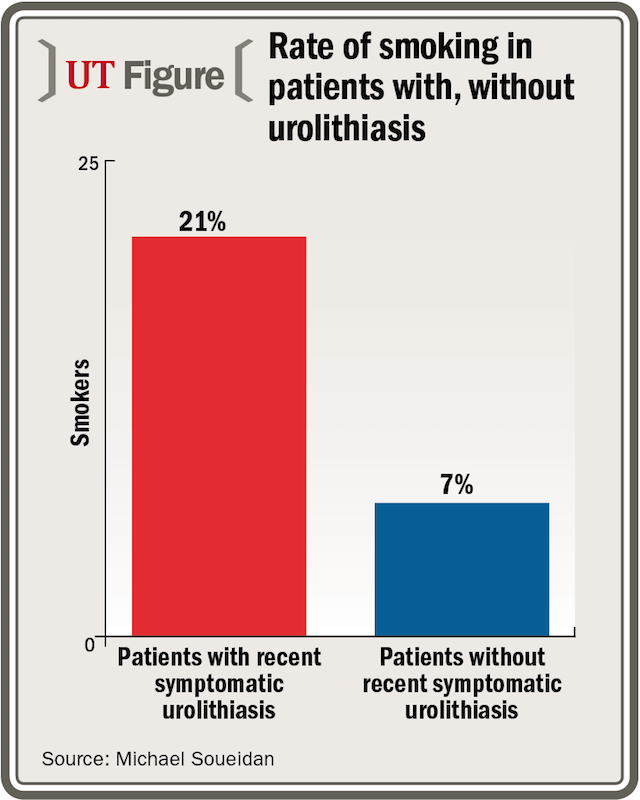Article
Smoking associated with greater risk of urolithiasis
Author(s):
Two-thirds of patients attending a urology clinic for the management of urolithiasis failed to meet physical activity guidelines. In addition, patients with recent symptomatic urolithiasis were significantly more likely to be current smokers than those without recent symptomatic urolithiasis, according to a recent study.
Montreal-Two-thirds of patients attending a urology clinic for the management of urolithiasis failed to meet physical activity guidelines. In addition, patients with recent symptomatic urolithiasis were significantly more likely to be current smokers than those without recent symptomatic urolithiasis, according to a recent study.
READ: What drives unplanned returns post-URS lithotripsy?
Assistance with smoking cessation, therefore, should be included in the routine management of urolithiasis, Michael Soueidan reported at the 2015 AUA annual meeting in New Orleans. The findings were subsequently published in the Canadian Urological Association Journal (2015; 9:257-62).
The effects of physical activity on urolithiasis remain unclear.
“The literature lacks consistent evidence of the relationship between physical activity and urolithiasis. In addition, the influence of smoking on urolithiasis has only been minimally explored,” said Soueidan, a medical student at McGill University Health Centre, Montreal, who worked on the study with Sero Andonian, BSc, MSc, and colleagues.
ALSO READ: Non-adherence to stone meds raises hospitalization risk
Soueidan evaluated relationships between selected lifestyle factors and recent symptomatic urolithiasis through surveys administered to a convenience sample of stone clinic patients attending a tertiary care hospital.
Participants completed a questionnaire querying:
• socio-demographic characteristics
• medical history
• smoking and alcohol habits
• use of supplements and medications (with dosages), including vitamin D and calcium
• diet (animal protein, oxalate, and salt consumption) and water intake
• sitting time and leisure time physical activity, as measured by the International Physical Activity Questionnaire (IPAQ)
• lower urinary tract symptoms and quality of life, using the AUA Symptom Score (AUASS).
NEXT: Results
Participants were classified as those with recent symptomatic urolithiasis or without recent symptomatic urolithiasis. Recent symptomatic urolithiasis was defined as having one or more symptomatic urinary stones within the previous 6 months. The two groups were compared using Student’s t-test and chi-squared test, and multivariate logistic regression was performed.
One hundred sixty-seven questionnaires were collected; four were incomplete and were excluded. Sixty-four percent of the participants were male and 78% were Caucasian. Their mean age was 56.3 years and their mean body mass index (BMI) was 27.3 kg/m².
YOU MIGHT LIKE: Breaking new ground (And kidney stones) with ultrasound

Fifty-seven (35%) of the participants reported recent symptomatic urolithiasis. There were no significant differences between patients with and without recent urolithiasis in age, sex, race, or BMI. Water, alcohol, calcium, vitamin D, salt, protein, and oxalate intake were also similar between groups. Symptom and quality-of-life scores on the AUASS were also not significantly different between the two groups.
One-fifth (21%) of individuals with recent symptomatic urolithiasis were smokers compared with 7% without recent symptomatic urolithiasis (p=.021). After controlling for sex, BMI, diet, and exercise, patients with recent symptomatic urolithiasis were 8.5 times more likely (p=.002) to be current smokers compared with those without recent symptomatic urolithiasis.
Few meet physical activity guidelines
Of the remaining 163 IPAQ questionnaires, 15 were excluded for reporting extreme values of physical activity (ie, >16 hours per day). Among the remaining 148 participants, only 52 (35%) met IPAQ physical activity guidelines. Fewer than one-fourth reported sufficiently moderate activity, and fewer than 20% reported sufficient vigorous activity. Reports of leisure time physical activity and sitting time were similar between the groups.
INTERESTING: Does stone-related atherosclerosis start in childhood?
In the group with recent symptomatic urolithiasis, vigorous exercise and total metabolic equivalents-minutes per week were moderately and directly associated with water intake.
NEXT: Two studies examin the relationship between physical activity and urolithiasis with contradicting results.
Two studies have examined the relationship between physical activity and urolithiasis with contradicting results.
In one study (J Am Soc Nephrol 2014; 25:362-9), women with higher levels of aerobic exercise were 16% to 31% less likely to develop stones.
“However, they only examined postmenopausal women and they did not validate self-reported urolithiasis,” Soueidan said.
These results were contradicted by Ferraro et al (J Urol 2015; 193:864-8), who found that in men and women of various ages, there was no significant relationship between exercise and urolithiasis. This study did not include men <40 years of age and 95% of the participants were Caucasian.
RECOMMENDED: Pre-op antibiotics sufficient to prevent UTI during stone Tx
Two other studies (Int J Urol 2005; 12:859-63; Nephrourol Mon 2013; 5:702-5) reported a significant association between smoking and urolithiasis, consistent with the present study, but a stronger relationship between smoking and urolithiasis was observed in Soueidan’s study.
“Future studies should provide objective measurements of physical activity and clarify effects of exercise intensity, sitting time, and smoking on urolithiasis,” he said.
Newsletter
Stay current with the latest urology news and practice-changing insights — sign up now for the essential updates every urologist needs.
















